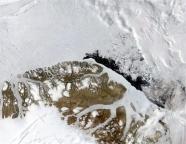(AFP) – 4 days ago

Broken ice floats in the Arctic Ocean off the northern
coast of Greenland in this 2004 true-color NASA image
CHICAGO — The nightmare global warming scenario which provided the plot for
a Hollywood blockbuster -- the Atlantic Ocean current that keeps Europe warm
shuts down and triggers rapid climate change -- has long worried scientists.
But a study published Thursday in the journal Science found it may not occur
as quickly as previously feared.
There is evidence that this current has shut down with some regularity in
the past -- and sometimes quite rapidly -- in response to large influxes of
fresh water from melting glaciers.
However, it appears as though the current rate of glacial melt is occurring
at a more gradual pace which will "give ecosystems more time to adjust to
new conditions," said study coauthor Peter Clark, a professor of geosciences
at Oregon State University.
"Our data still show that current is slowing, and may decline by 30 percent
by the end of this century," Clark said.
"That's very significant, and it could cause substantial climate change. But
it's not as abrupt as some concerns that it could shut down within a few
decades."
Clark and his colleagues constructed a massive computer model which
simulated the atmospheric and oceanic conditions of the height of the last
ice age and the changes which resulted in the Earth's last major global
warming some 14,500 years ago.
The simulation presented results that are in line with the fossil and
geological record and confirms the accuracy of some models of future climate
change scenarios.
It found that the "climate dominos" began to fall when the glaciers which
blanketed most of North America began to melt, said co-author Zhengyu Liu,
director of the Center for Climatic Research at the University of
Wisconsin-Madison.
Massive amounts of water poured into the North Atlantic and lowered the
ocean's salt levels, which are key to powering the convection current that
carries warm tropical surface water north and cooler, heavier subsurface
water south.
The fresh water stopped the current, cooling the North Atlantic region and
causing heat to build up in southern waters.
The cooler temperatures slowed the glacial melt and eventually the ocean
current restarted. But there was a much larger reserve of heat to haul
north.
"All that stored heat is released like a volcano, and poured out over
decades," Liu said in a statement.
"That warmed up Greenland and melted (arctic) sea ice."
While the model was not able to determine the rate of ice melt during the
period, it found that both a slow decrease and a sudden end to melt run-off
resulted in the same consequence: a 15-degree warming.
"That happened in the past," Liu said. "The question is, in the future, if
you have a global warming and Greenland melts, will it happen again?"
The researchers continue to run the massive program, which has simulated
about a third of the last 21,000 years.
It will eventually run up to the present and then 200 years into the future.
Copyright © 2009 AFP. All rights reserved.